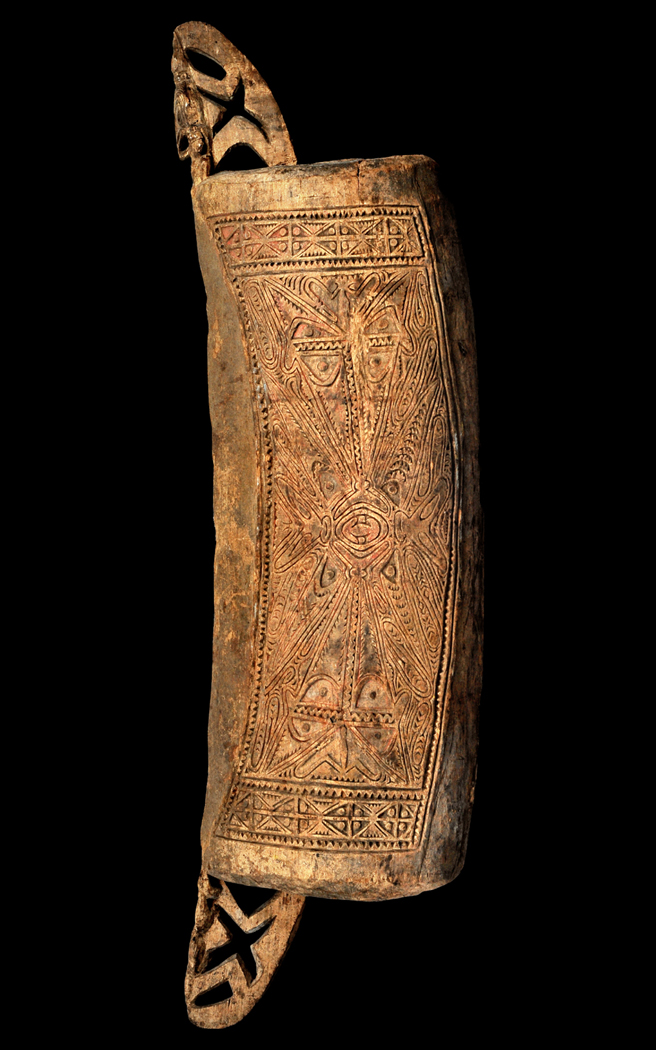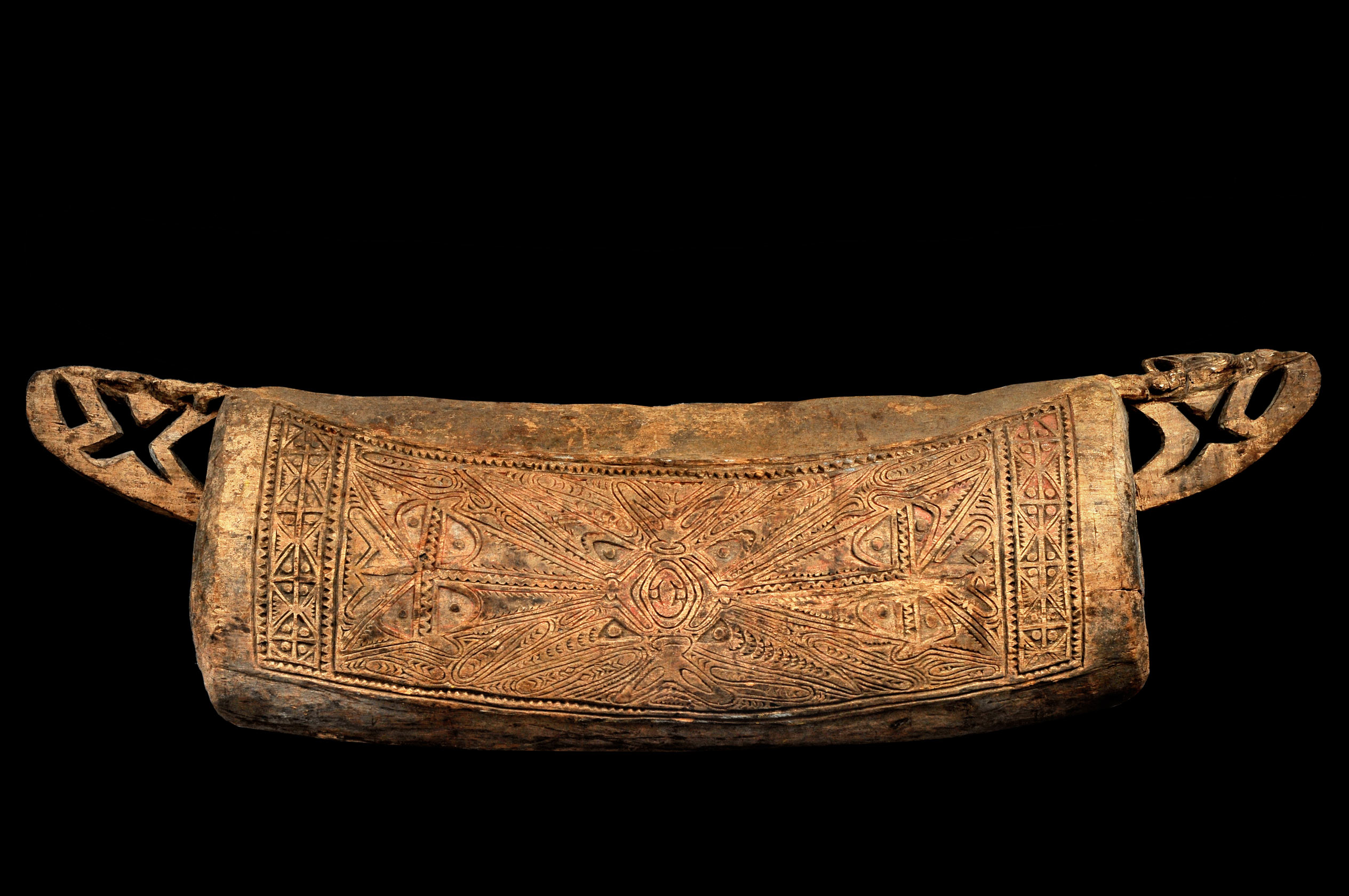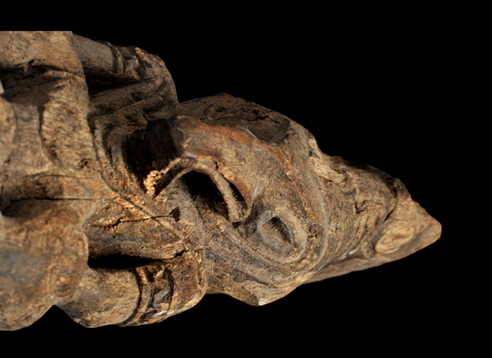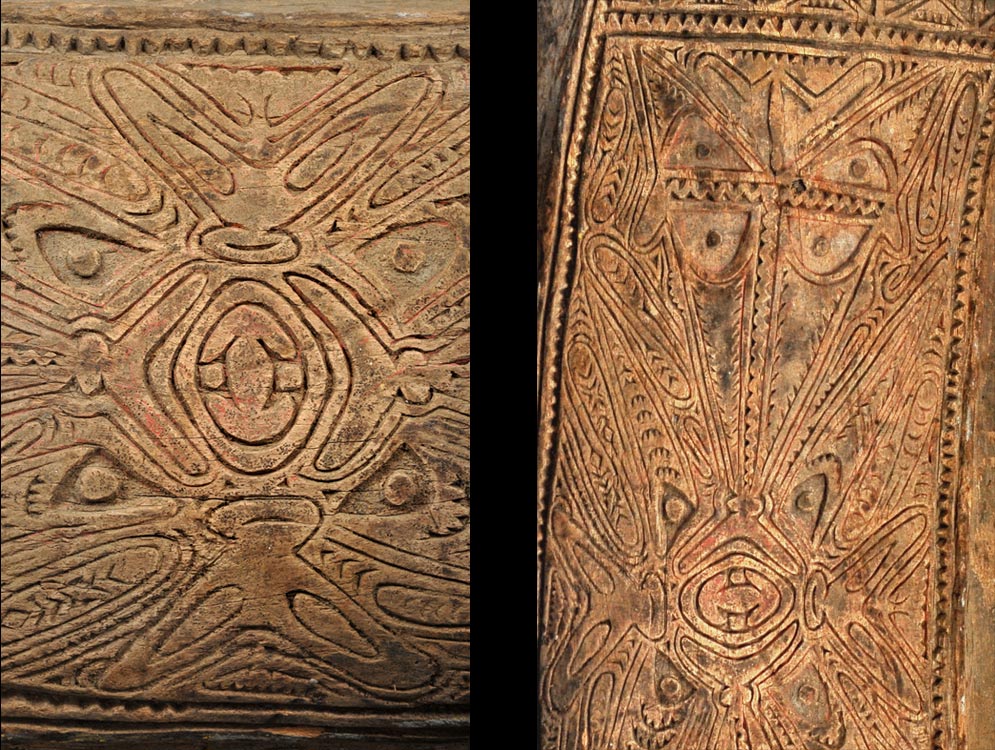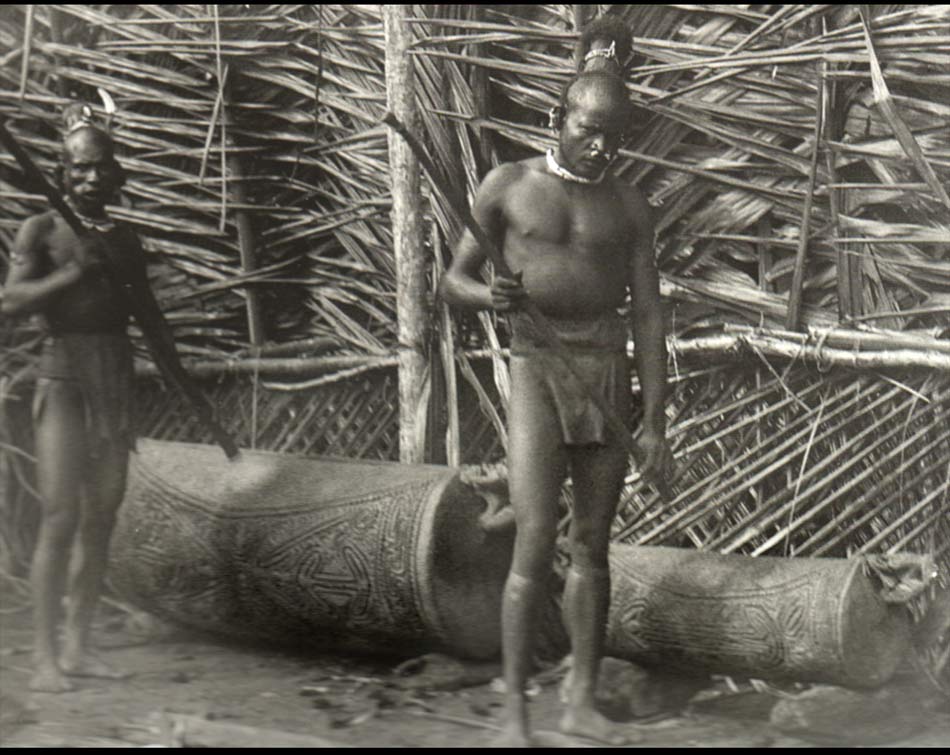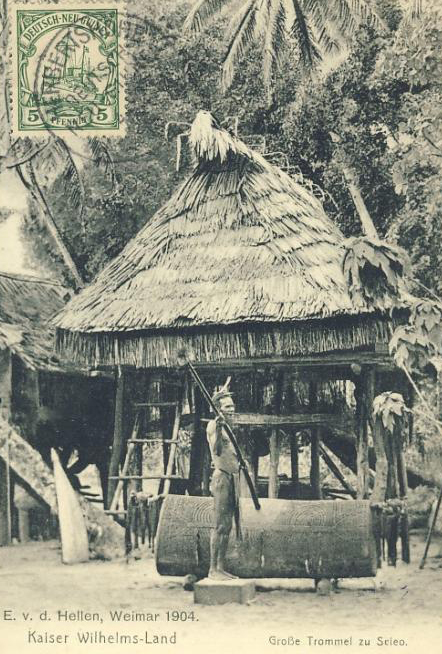DRUMS OF THE WORLD
New Guinea
garamut drum Sepik Ramu Area New Guinea
garamut drum Sepik / Ramu Area New Guinea / garamut Schlitztrommel Neuguinea
„These gongs are characterised by bilateral symmetry: the finials at each end of the gong are carved the same– either as faces resembling bragmasks, or kandimboang figures(...), usually supported by an animal such as a lizard or possum. The lavishly carved sides of the gong are also of bilateral symmetrical design depicting several motifs that refer to spirits, or to features or creatures of the natural world.
The primary production center for slit- gongs is the Ramu River delta, inhabited by the Kayan-Boroi and Bosmun, among others (Tranel 1952: 459; Damm 1967: 43; Blackwood 1951; 279), but the trade is carried out by the Manam Islanders who act as middlemen trading up and down the coast (Wedgewood 1933: 395).
The primary function of the eastern coast slit-gong lies in its utility as a transmitter of news, messages, announcements and directives. This is an ability shared by nearly all the Melanesian slit-gongs. Messages are sent by means of a code beaten out on the instruments; personal names, geographical locations, calls for assembly, announcements of success in hunting, invitations to ceremonies and feasts, accusations of adultery, theft and murder, all have their equivalent in slit-gong code (J. Schmidt 1933: 330; Burridge 1959: 139; Blackwood 1951: 281).
The sculpture of the protruding lugs on the end walls is the most consistant feature of eastern coastal slit-gongs. Each lug forms a sculptural group of two figures: a more or less naturalistically rendered man — some times with a mask-like face, and an animal or creature who stands behind the human figure crouching against his back with its animal head resting directly above the human head.
The style of the sculpture is familiar, especially the human figures which closely resemble the small, ancestral figurines found all along the north coast of New Guinea and the Lower Sepik. It is well known that these small, personally owned figurines were believed to embody spirit ancestors who were able to intercede for man in the supernatural realm (Bühler 1962; 69; Cranstone 1961: 35; Kammerer)."
Informations about slit gongs given by Penney, David W. (1980). Northern New Guinea Slit-Gong Sculpture. Baessler-Archiv n.F. 38: 347–385.
"Garamut is the Pigin English term for slit-gong, or slit-drum, in Papua New Guinea. It is played only by coastal and river peoples. Garamuts consist of hollowed out logs with a slit along the topsite. Customs sorrounding the playing of the slit-gongs differ from one culture to the next, but usually players hold only one beater and play the instrument either ceremonially or to send a message to villagers out of sight but within a hearing range of the instrument. Large ones may be played by more than one player."
Informations about garamut drums given by Vida Chenoweth in: Musical Instruments of Papua New Guinea 1976
Bibliography:
Burridge, K. (1959) : The slit-gong in Tangu, New Guinea. Ethnos 24.pp.136-150
Chenoweth, Vida (1976) : Musical Instruments of Papua New Guinea
Craig, Barry : Slit Gongs of the Sepik and Madang Provinces.
Craig, Barry (1988) : Art and Decoration of Central New Guinea.
Craig, Barry ; Busse, Mark; Eoe, Soroi;(2010) : Living Spirits with Fixed Abodes - The Masterpieces Exhibition Papua New Guinea National Museum and Art Gallery.
Eberlein, P.J.(1910): Die Trommelsprache auf der Gazellehalbinsel, Neupommern, Antrhopos 5
Fischer, H. (1986) : Sound producing instruments in Oceania.
Leach, J. (2002). Drum and voice : Aesthetics and social process on the Rai Coast of Papua New Guinea. Royal Anthropological Institute.
Penney, David W. (1980): Northern New Guinea Slit-Gong Sculpture. Baessler-Archiv n.F. 38: 347–385.
Sebeok, Thomas A. (1976); Umiker-Sebeok, Donna Jean : Speech Surrogates. Drum and whistle systems.
„These gongs are characterised by bilateral symmetry: the finials at each end of the gong are carved the same– either as faces resembling bragmasks, or kandimboang figures(...), usually supported by an animal such as a lizard or possum. The lavishly carved sides of the gong are also of bilateral symmetrical design depicting several motifs that refer to spirits, or to features or creatures of the natural world.
The primary production center for slit- gongs is the Ramu River delta, inhabited by the Kayan-Boroi and Bosmun, among others (Tranel 1952: 459; Damm 1967: 43; Blackwood 1951; 279), but the trade is carried out by the Manam Islanders who act as middlemen trading up and down the coast (Wedgewood 1933: 395).
The primary function of the eastern coast slit-gong lies in its utility as a transmitter of news, messages, announcements and directives. This is an ability shared by nearly all the Melanesian slit-gongs. Messages are sent by means of a code beaten out on the instruments; personal names, geographical locations, calls for assembly, announcements of success in hunting, invitations to ceremonies and feasts, accusations of adultery, theft and murder, all have their equivalent in slit-gong code (J. Schmidt 1933: 330; Burridge 1959: 139; Blackwood 1951: 281).
The sculpture of the protruding lugs on the end walls is the most consistant feature of eastern coastal slit-gongs. Each lug forms a sculptural group of two figures: a more or less naturalistically rendered man — some times with a mask-like face, and an animal or creature who stands behind the human figure crouching against his back with its animal head resting directly above the human head.
The style of the sculpture is familiar, especially the human figures which closely resemble the small, ancestral figurines found all along the north coast of New Guinea and the Lower Sepik. It is well known that these small, personally owned figurines were believed to embody spirit ancestors who were able to intercede for man in the supernatural realm (Bühler 1962; 69; Cranstone 1961: 35; Kammerer)."
Informations about slit gongs given by Penney, David W. (1980). Northern New Guinea Slit-Gong Sculpture. Baessler-Archiv n.F. 38: 347–385.
"Garamut is the Pigin English term for slit-gong, or slit-drum, in Papua New Guinea. It is played only by coastal and river peoples. Garamuts consist of hollowed out logs with a slit along the topsite. Customs sorrounding the playing of the slit-gongs differ from one culture to the next, but usually players hold only one beater and play the instrument either ceremonially or to send a message to villagers out of sight but within a hearing range of the instrument. Large ones may be played by more than one player."
Informations about garamut drums given by Vida Chenoweth in: Musical Instruments of Papua New Guinea 1976
Bibliography:
Burridge, K. (1959) : The slit-gong in Tangu, New Guinea. Ethnos 24.pp.136-150
Chenoweth, Vida (1976) : Musical Instruments of Papua New Guinea
Craig, Barry : Slit Gongs of the Sepik and Madang Provinces.
Craig, Barry (1988) : Art and Decoration of Central New Guinea.
Craig, Barry ; Busse, Mark; Eoe, Soroi;(2010) : Living Spirits with Fixed Abodes - The Masterpieces Exhibition Papua New Guinea National Museum and Art Gallery.
Eberlein, P.J.(1910): Die Trommelsprache auf der Gazellehalbinsel, Neupommern, Antrhopos 5
Fischer, H. (1986) : Sound producing instruments in Oceania.
Leach, J. (2002). Drum and voice : Aesthetics and social process on the Rai Coast of Papua New Guinea. Royal Anthropological Institute.
Penney, David W. (1980): Northern New Guinea Slit-Gong Sculpture. Baessler-Archiv n.F. 38: 347–385.
Sebeok, Thomas A. (1976); Umiker-Sebeok, Donna Jean : Speech Surrogates. Drum and whistle systems.
